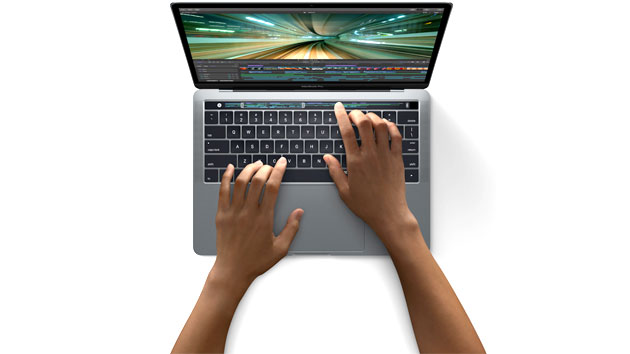Integrated OLED Touch Bar Offers Easy, Context-Sensitive Interaction with Editorial Tools and Timeline in New Update
Apple's MacBook Pro workstation line-up finally got a refresh with today's announcement of new models featuring up to four Thunderbolt 3 ports, Intel Core i7 processors running at up to 3.3GHz (3.6GHz with turbo boost), and new Radeon Pro 400 Series graphics options topping out at the Radeon Pro 460 with 4GB memory.
The big innovation this time around is the Touch Bar — basically a skinny multitouch OLED display that runs across the top of the keyboard, replacing the function key with a display of soft "keys" as contextual options depending on what the computer is being used for. Wooing content creators, Apple spent time during the MacBook Pro announcement demonstrating how the Touch Bar works with Final Cut Pro.
That's right. Apple gave Final Cut Pro X some much-needed love today, too, describing the new update as the biggest since FCP X's controversial launch five years ago. The Touch Bar eliminates the need to memorize quite as many keyboard shortcuts or use the application's on-screen interface to switch between editing tools, change audio levels, or issue trimming and playback commands.
The Final Cut Pro X timeline can be navigated using the Touch Bar. Click to load a high-resolution version.
The MacBook Pro Touch Bar can even show an interactive overview of the current timeline, enabling touch navigation without a full-on touchscreen display. This looks like it could be a genuine enhancement and upgrade to the typical editorial experience, extending the usability of the computer keyboard in interesting ways — and keeping your right hand off the mouse.
Additionally, the FCP X 10.3 interface has been redesigned with a darker, flatter look, and screen arrangements can be switched up depending on whether users are digging through their media, editing on the timeline, or color grading. Other new features in v10.3 include wide color gamut (Rec. 2020) support, "flow transition," designed to make jump cuts invisible, a "remove attributes" feature allowing effects to be deleted (or reused) on multiple clips, a timecode generator and overlay effect, support for ProRes MXF and Panasonic V-Log, plus AVC-Intra export.
What else is new in the pro video toolkit? Motion 5.3 has also been redesigned to support Rec. 2020 color space, 3D text enhancements for titling, a new "align to" animation behavior, and Touch bar integration. Compressor 4.3 also gets the new interface, wide color gamut support, and Touch Bar support for setting up batch jobs and adding markers. Final Cut Pro X 10.3 is a free update for existing users, and $300 for new users. Motion 5.3 and Compressor 4.3 are also free for existing users, but $49.99 each for newbies.
But it wasn't all good news on the pro front — the most recent Mac Pro design (affectionately known as the "trash can" Mac) continues to languish without upgrades. And some British users took to Twitter to express their disgust after realizing the price of the three-year-old computer had increased by upwards of £500, likely owing to currency fluctations.
Wait, what? Mac Pro, released 3yrs ago, not updated, gets a £500 price hike. Let that sink in. /cc @nicklockwood
— Milen Dzhumerov (@milend) October 27, 2016
A 13-inch MacBook Pro with the Touch Bar starts at $1,799; the fully loaded 15-inch version spec'd out with a 2.9GHz quad-core i7 CPU, 16 GB of RAM, 2 TB of PCIe SSD storage, and Radeon Pro 460 graphics will run you a cool $4,299.
Sections: Technology
Topics: apple fcp x Mac Pro MacBook Pro
Did you enjoy this article? Sign up to receive the StudioDaily Fix eletter containing the latest stories, including news, videos, interviews, reviews and more.

